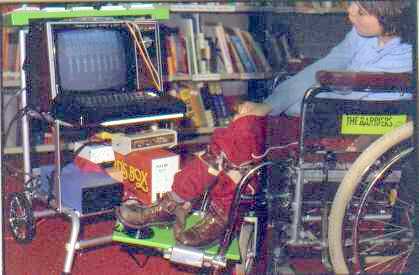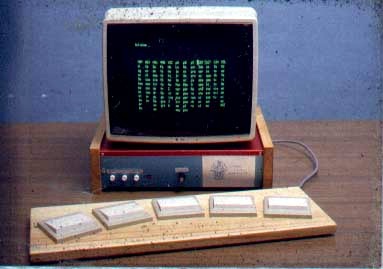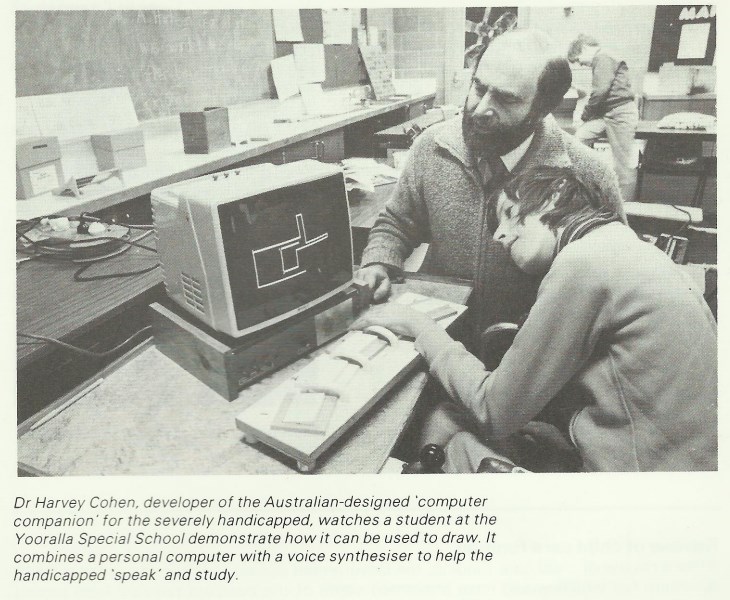In 1984-5 Australia became the world leader in providing communication aids for the very severely disabled speechless.

Prototype Talking Communicator operated by a child capable only of activating a foot-control key. Computer used was an OZNAKI Project "Wizard's Box", a 1976 8-bit microcomputer called the Poly-88, a North Star floppy disc, and a commercial phoneme generator based on the SC-01 speech chip, mounted on a video cart, together with teacher's keyboard and TV modified to function as a display.
The prototypes for the La Trobe University Talking Communicator were developed using the resources of the OZNAKI Project, which was funded by the Education Research and Development Commission (ERDC) from 1976-1982 (when the ERDC was the victim of a Federal Government Razar Gang). Using the proptotypes developed as a base, funds amounting to $75,000 were secured from the Australian Schools Commission, for a project entitled:
Computer Speech Communication, Access, and Programming by Severely Handicapped Non-Speech Children"
A total of nine Talking Communicators were assembled and delivered to the Yooralla Special School, in Glenroy, a suburb of Melbourne. Within the box, was the mother board of the first Australian PC, the MicroBee A description of the project at the roll-out stage is available in the downloadable paper, Harvey A, Cohen The La Trobe Talking Communicator for the Severely Disabled Speechless, A.H. Sale and G. Hawthorne, Editors, Proceedings of the Ninth Australian Computer Conference, Hobart, Australian Computer Society, Hobart, Vol 1 pp 266-275 (1982).

The La Trobe Talking Communicator

A well written newspaper account of the "computer companion" as it was conceived when delivered to Yooralla Special School Glenroy is here
The La Trobe Talking Communicator aka "The Computer Companion" for severely disabled speechless, arose out of the OZNAKI educational project
Other Computer Technology for the Handicapped
- Computing by and for the Intellectually Impaired
Summary History of the Talking Communicator Project
Funds amounting to $57,000 were secured from the Australian Schools Commission, at the beginning of 1982, for a project entitled:
"Computer Speech Communication, Access, and Programming by Severely Handicapped Non-Speech Children"
This project met its aims of providing communications, and a battery of nine Talking Communicators were constructed and programmed to meet the needs of the more severely non-vocal handicapped at the Yooralla Special School, Glenroy. Within the time constraint working vocabulary systems were implemented for students capable of handling a live key or a single key input. Five key and one-key versions of the OZNAKI Programming language WHAM were implemented, both to run on the Talking Communicator and the Apple ][. A simple drawing programmed (featured in accompanying image) as well as a Hangman game was written with one and 5-key user interface. This provided an introduction toideas of computer control, but not the "access and programming" of the project's title. At the end of 1982, there was still $13,000 of funds remaining, whilst menus would require further customising to meet the direct "writing" needs of particular students. This menu customisation required only the most minimal computer skills, but any significant reorganisation as envisaged by Dr Cohen, and further extension of the units to meet the needs of these students required the skills of Dr Cohen.
But after the most successful completion of the first year of the project, an amazing decision was made by the Schools Commission, who saw the Talking Communicator solely as a typewriter system: Full control of the project was granted to the Yooralla School, with restricted goals of providing a facility for computer output of text by the students involved. The computer illiterate teachers were in total control, along with the modestly skilled primary teacher who had been employed by the Project during 1982 in the actual teaching of the handicapped children. He was capable of modifying menus but not of any significant reorganisation. The Schools Commission considered that the actual inventor/developer was no longer needed at all. The Schools Commission continued to fund this project grossly reduced in scope for a further six years.